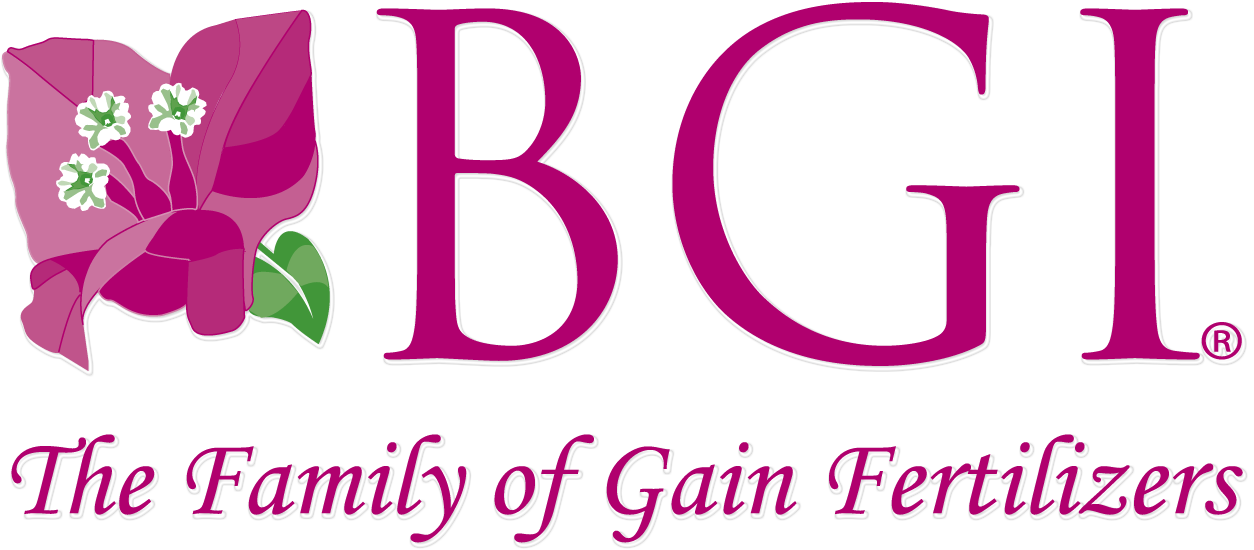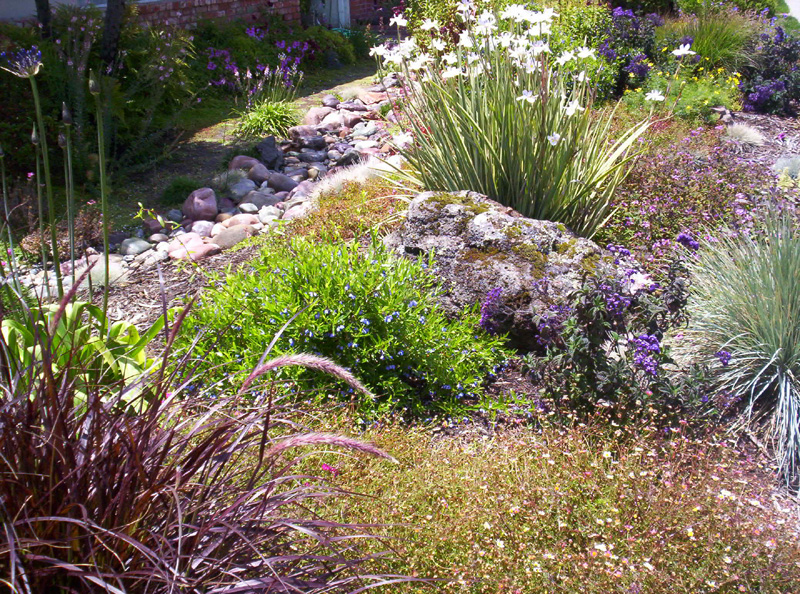Xeriscaping refers to landscaping in ways that do not require supplemental irrigation. It is promoted in areas that do not have easily accessible supplies of fresh water. The word Xeriscaping [zeer-i-skey-ping,] was coined by combining xeros (Greek for “dry”) with landscape. Plants whose natural requirements are appropriate to the local climate are emphasized, and care is taken to avoid losing water to evaporation and run-off.
Xeriscaped landscaping in Florida or in any other state does not mean tearing out the lawn and putting in rocks and desert plants such as cacti, euphorbia and agaves. Rather, properly approached, a xeriscaped landscape will allow you to use a wide variety of plants, but insists on common-sense measures that will help to conserve water, such as grouping plants with similar water requirements together, reducing the use of lawn grass, and using indigenous plants (plants which are adapted to the local climate and require less water than exotics usually do). Plants most suited to xeriscaped landscaping, such as Bougainvillea, are sometimes referred to as “xeric” plants.
Implementation
Implementation of xeriscaping includes:
Appropriate choice and arrangement of a plant (or plants) – where possible, plants that are native to the area or to similar climates, as well as other plants that tolerate or avoid water stress (xerophytes, halophytes, summer-dormant bulbs, very deeply rooted plants) as ornamentals.
Hydrozoning, grouping plants with similar watering requirements together is quite necessary. Plants that require more water (for example, vegetables, fruits, and certain flowers) are grouped together. These less water-efficient plants may also be sheltered from the wind and/or sun by planting them in the shade (under trees, beside a house etc.) to decrease the amount of water they need.
Minimal turf areas, using drought-tolerant turf-grass species where turf is needed at all (children’s play areas). The landscape can be filled in with borders and islands of more water-efficient ornamental plants.
Efficient application of water – drip irrigation where possible. Overhead irrigation (where needed) is applied in the morning or evening, when it is less likely to be blown away by wind or lost by evaporation. Drought-tolerant plants get no more water than they need to look good, and of course water is not allowed to splash onto concrete walkways or other areas where it is not needed.
Conservation of water in the soil. Soil with improved structure retains water better, and mulch cools the soil surface and hinders evaporation.
Advantages
- lower water bills
- more water available for other uses and other people (such as showers, sinks, hoses)
- less time and work needed for maintenance, making gardening more simple and stress-free
- little or no lawn mowing (which saves gas)
- xeriscape plants along with proper bed design tends to take full advantage of rainfall
- when water restrictions are implemented, xeriscape plants will tend to survive, while more traditional plants may not
- increased habitat for native bees, butterflies, and other fauna
Disadvantages
- requires planning, especially if color is desired throughout the season, as most perennials do not bloom continuously
- may require more start-up work to prepare beds for planting than simply laying sod
- some homeowners’ associations may object to non-traditional plants. However, some states, such as Florida, include law, as it pertains to Homeowner’s Associations, that make it unlawful to include a clause prohibiting “property owner from implementing Xeriscape or Florida-friendly landscape, as defined in s. 373.185(1), on his or her land.” in Homeowner Association documents, (Ref: 720.3075.4 Prohibited clauses in association documents)
- requires that people moving from water-abundant to water-scarce areas change their mind set as to what types of plants they are able to practically and economically maintain
- may have to substitute one type of plant for another
- xeriscape beds require periodic maintenance which is more involved than simply mowing and edging, especially to maintain color. Weeds and trash may also be more of a problem than in a traditional lawn.
- more complicated irrigation systems may be required.
- xeriscape plants can waste water if irrigation is not properly managed.
“Florida Favorites”
Some people think of a desert scene when they hear “Xeriscape,” but this is not the look of a typical Xeriscape. Some of the “Florida Favorites” you can use for your Xeriscape landscape are listed here, courtesy of the South Florida Water Management District. Several of them are lush and tropical-looking like the bougainvillea, and will add to the beauty of your landscape while conserving water.
Consult your nursery professional for information on which of these plants are appropriate for your region.
Trees
- Bald cypress (Taxodium distichum)
- Dahoon holly (Ilex cassine)
- Geiger tree (Cordia sebestena)
- Gumbo Limbo (Bursera simaruba)
- Ironwood (Krugiodendron ferreum)
- Live oak (Quercus virginiana)
- Magnolia, southern (Magnolia grandiflora)
- Magnolia, sweet bay (Magnolia virginiana)
- Myrsine (Rapanea guianensis)
- Paradise tree (Simarouba glauca)
- Pigeon plum (Coccoloba diversifolia)
- Red bay (Persea borbonia)
- Red maple (Acer rubrum)
- Sea grape (Coccoloba uvifera)
- Silver buttonwood (Conocarpus erectus var. sericeus)
- Simpson’s stopper (Myricanthes fragrans)
- Slash pine (Pinus elliottii)
- Southern red cedar (Juniperus silicicola)
- Trumpet tree (Tabebuia spp.)
Shrubs
- Beautyberry (Callicarpa americana)
- Cocoplum (Chrysobalanus icaco)
- Coral bean (Erythrina herbacea)
- Crinum lily (Crinum asiaticum)
- Firebush (Hamelia patens)
- Florida privet (Forestiera segregata)
- Holly, Stokes dwarf (Ilex vomitoria)
- Jamaica caper (Capparis cyanophallophora)
- Marlberry (Ardisia escallonioides)
- Necklace pod (Sophora tomentosa)
- Walter’s viburnum (Viburnum obovatum)
- Wax myrtle (Myrica cerifera)
- White indigo berry(Randia aculeata)
- White stopper (Eugenia axillaris)
- Wild coffee (Psychotria nervosa)
- Wild coffee, dwarf (Psychotria ligustrifolia)
Palms and Cycads
- Buccaneer or Sargent’s palm (Pseudophoenix sargentii)
- Cabbage palm (Sabal palmetto)
- Coontie (Zamia pumila)
- Paurotis/Everglades palm (Acoelorrhaphe wrightii)
- Queen sago (Cycas circinalis)
- Royal palm (Roystonea elata)
- Saw palmetto (Serenoa repens)
- Thatch palm (Thrinax spp.)
Ferns
- Boston fern (Nephrolepis exaltata)
- Leather fern (Acrostichum danaeifolium)
- Swamp fern (Blechnum serrulatum)
Accent Grasses, Vines and Groundcovers
- Bougainvillea (Bougainvillea spp.)
- Coral honeysuckle (Lonicera sempervirens)
- Cordgrass (Spartina bakeri)
- Corky-stemmed passion-flower (Passiflora suberosa)
- Fakahatchee grass (Tripsacum dactyloides)
- Florida gama grass (Tripsacum floridanum)
- Lantana, trailing (Lantana montevidensis)
- Liriope (Liriope muscari)
- Mondo grass (Ophiopogon japonicus)
- Purple love grass (Eragrostis spectabilis)
- Railroad vine (Ipomoea pes-caprae)
- Sea oats (Uniola paniculata)
Annuals/Perennials/Wildflowers
- Beach sunflower (Helianthus debilis)
- Black-eyed Susan (Rudbeckia hirta)
- Blanket flower (Gaillardia pulchella)
- Lantana, pineland (Lantana depressa)
- Lantana, wild (Lantana involucrata)
- Pentas (Pentas lanceolata)
- Porter weed (Stachytarpheta jamaicensis)
- Sea oxeye daisy (Borrichia frutescens)
- Spider lily (Hymenocallis latifolia)
- Tickseed (Coreopsis leavenworthii)
Xeriscape and save time, money, water, and our environment! For more information, go to sfwmd.gov.


